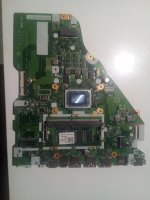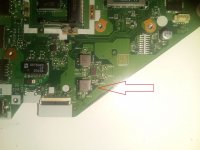Hi everyone. I think the title sums it up pretty well. The main voltage rail seems fine, the 5V rail is fine, the 1.1V rail for the CPU looks fine as well, but the 3.3V rail shuts down a split second after power up. I can measure it, just barely, before it shuts down. Meanwhile the power LED flashes white continuously. According to the laptop manual, a slow blinking white power LED means the lapto is in sleep mode. The board is drawing some 600mA in the process and the fan is not spinning. The CPU gets pretty toasty to the touch after a while if I leave it like that, so I don't leave it on for too long. Any pointers, please?
Thanks.
There are no shorts, as far as I can tell. The 3 coils next to the CPU measure 2 ohms and they read 1.1V, which seems consistent with the correct Vcore for the CPU. The coil next to the battery reads 22K ohms and when I plug the charger there are initially 8V there (the battery voltage, I guess) then goes to 0V after a few seconds. The 5V rail is present, reads 240 ohms. The 3.3V rail shown in the pictures reads 29 ohms and measures 3.3V for a split second before going to 0V. On the other side of the board there are two more coils, both not shorted. One of them reads 230 ohms and 0.9V and the other one 45 ohms and 1.2V


Thanks.
There are no shorts, as far as I can tell. The 3 coils next to the CPU measure 2 ohms and they read 1.1V, which seems consistent with the correct Vcore for the CPU. The coil next to the battery reads 22K ohms and when I plug the charger there are initially 8V there (the battery voltage, I guess) then goes to 0V after a few seconds. The 5V rail is present, reads 240 ohms. The 3.3V rail shown in the pictures reads 29 ohms and measures 3.3V for a split second before going to 0V. On the other side of the board there are two more coils, both not shorted. One of them reads 230 ohms and 0.9V and the other one 45 ohms and 1.2V


